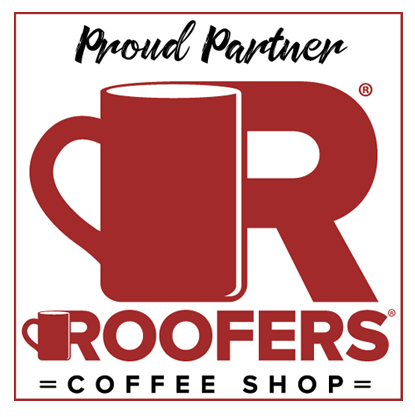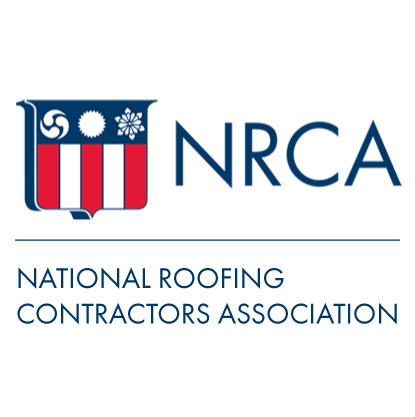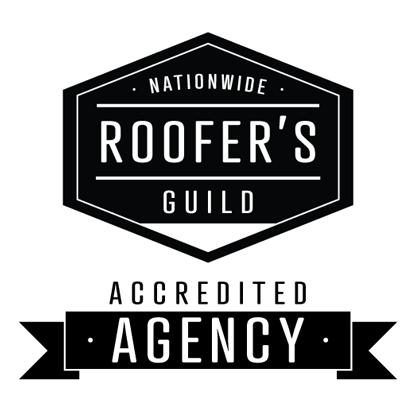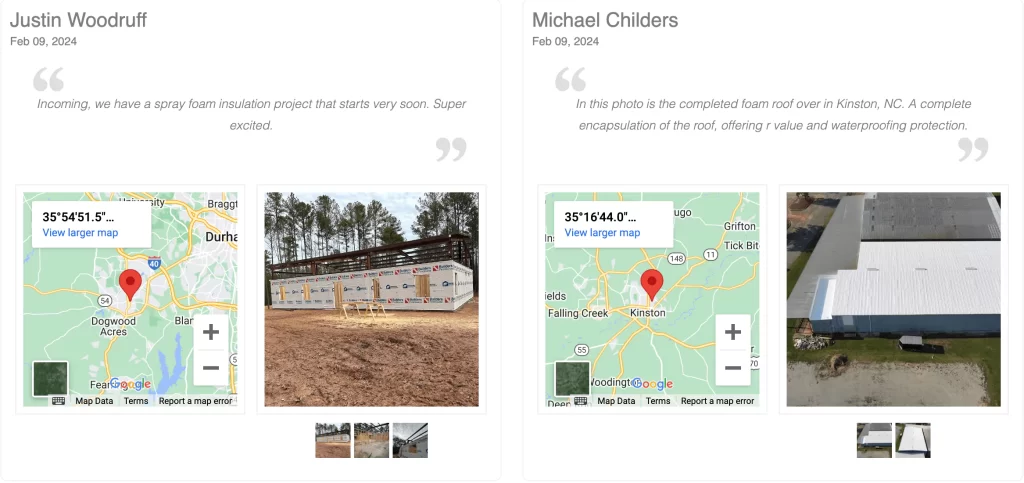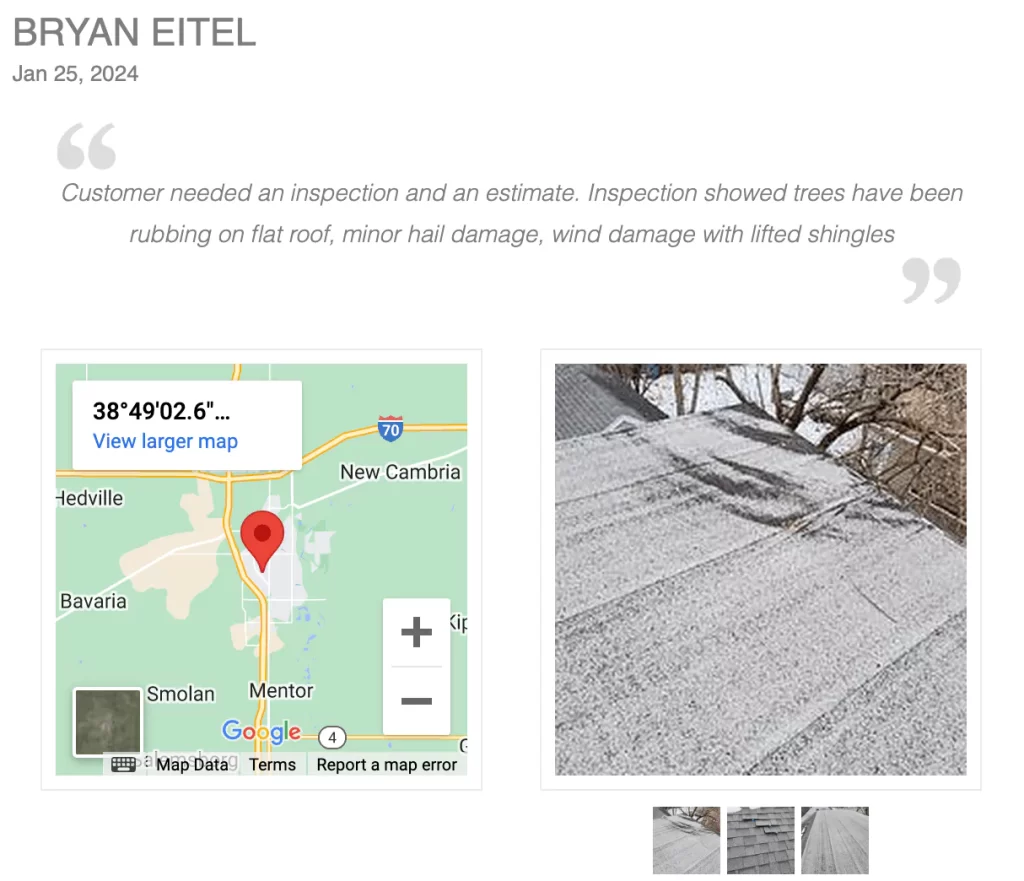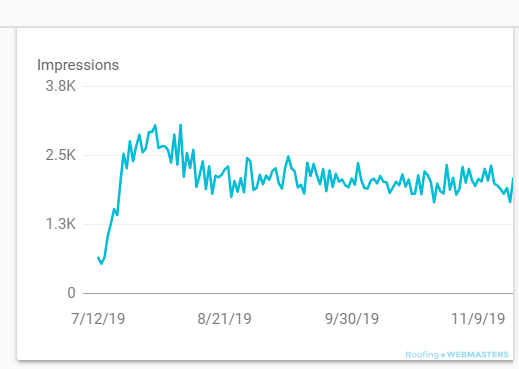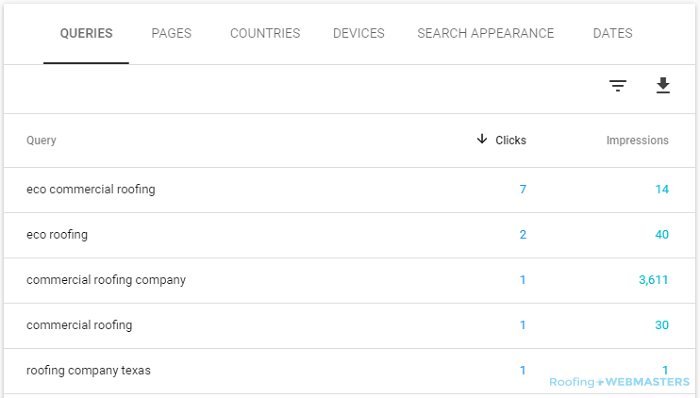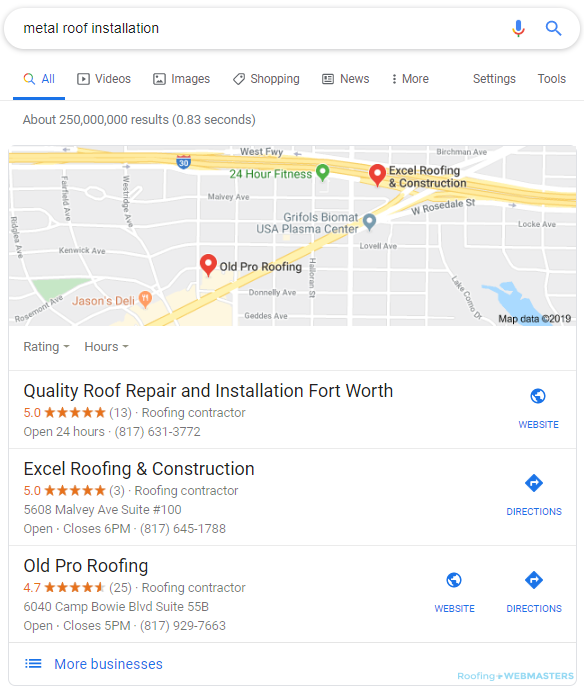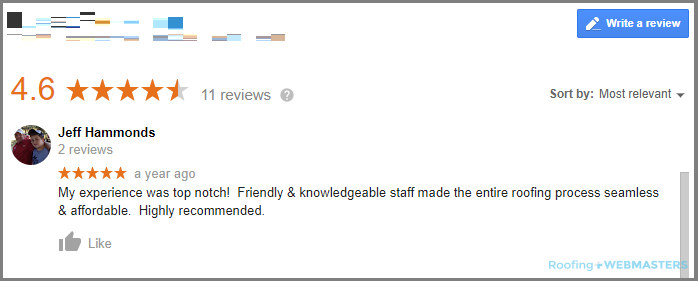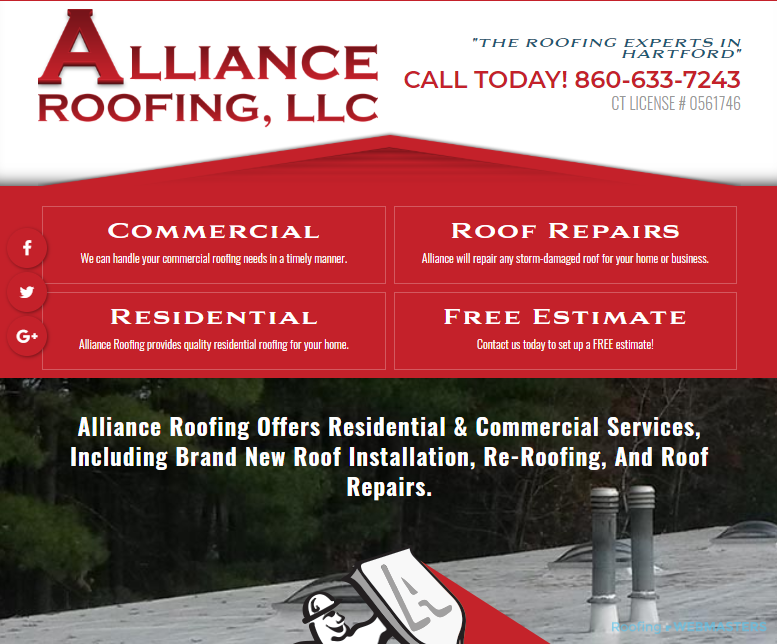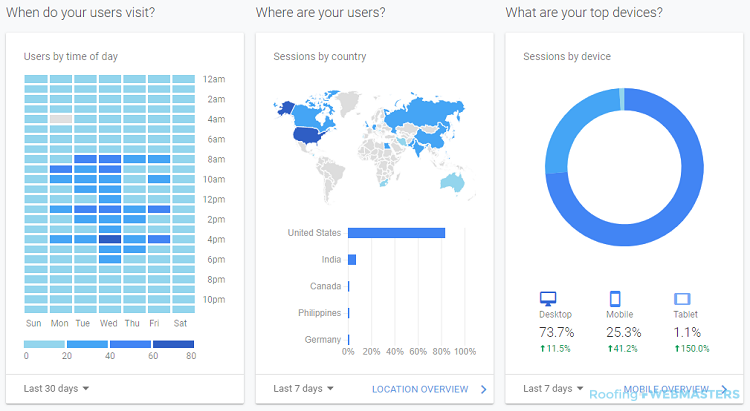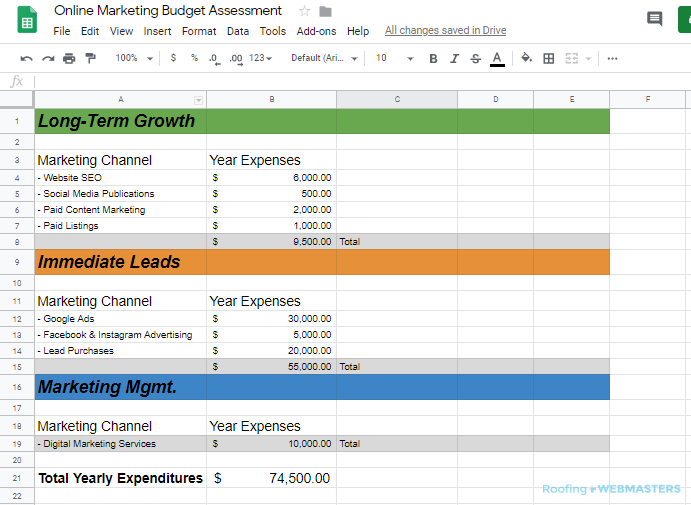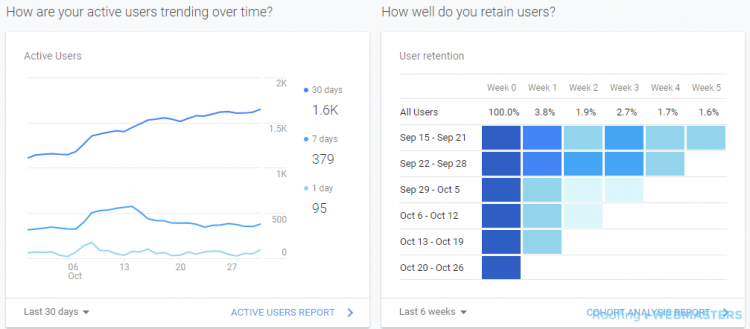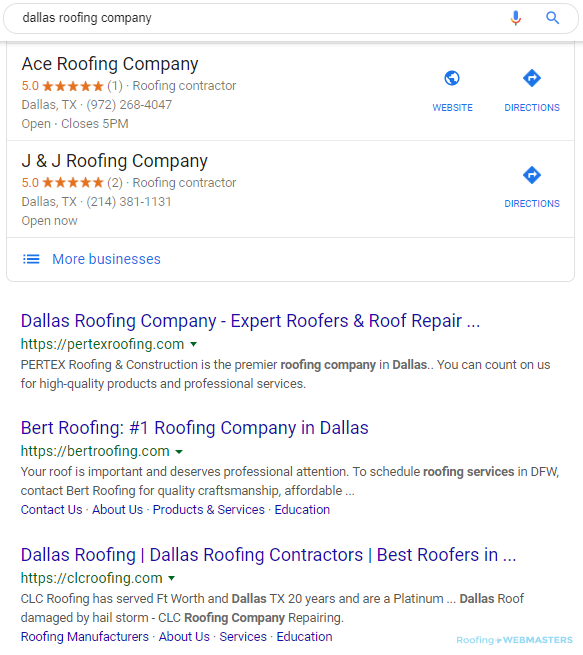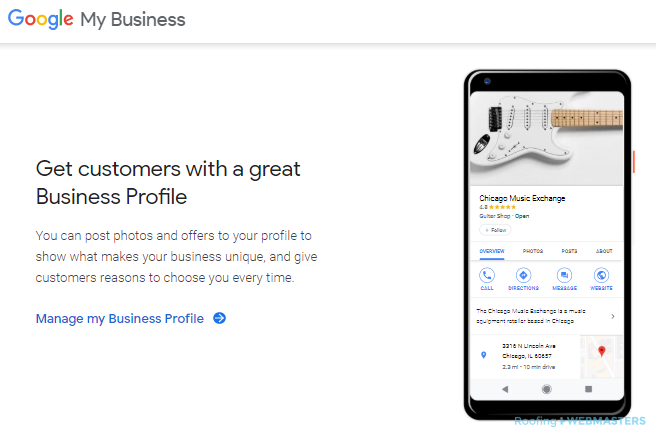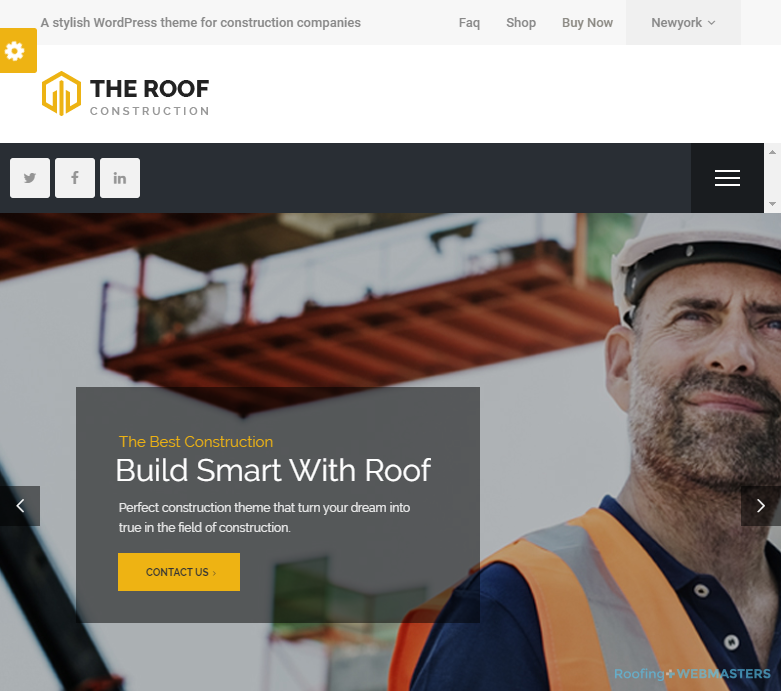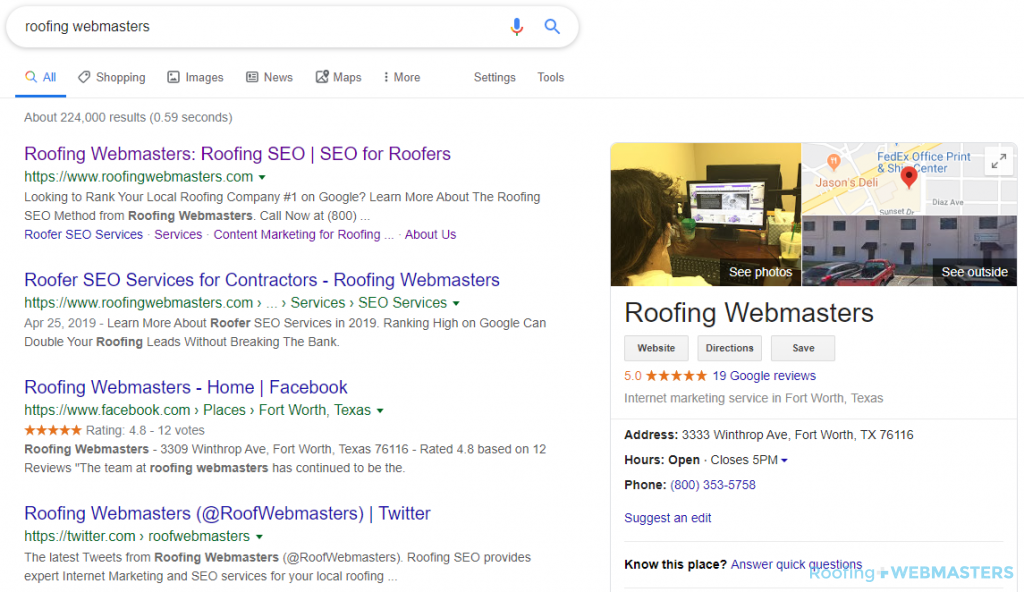Roofing SEO is about making your roofing company’s website and business listings rank on Google search results. By appearing on the world’s top search engine, you attract the highest-quality leads and the greatest return on investment.
However, to achieve SEO success, you must follow a set of proven techniques to ensure that your website and listings comply with Google’s guidelines and attract the right types of visitors.
This guide is based on my 10+ years in the SEO industry. But before I dive into all of the nuances of search engine optimization, I want to provide context as to why you might find this guide particularly helpful and relatable.
I’m Nolen Walker with Roofing Webmasters, an SEO agency for roofing companies like yours. I started my agency back in 2013 after some marketers overcharged my home service business and failed to deliver results.
The behavior of these marketers inspired me to start an SEO agency for people like you and me.
This shared experience of dealing with self-serving marketers gives me a unique, empathetic position from which I operate my company today.
Furthermore, it allows me to address the pain points of regular business owners who want to grow their businesses online.
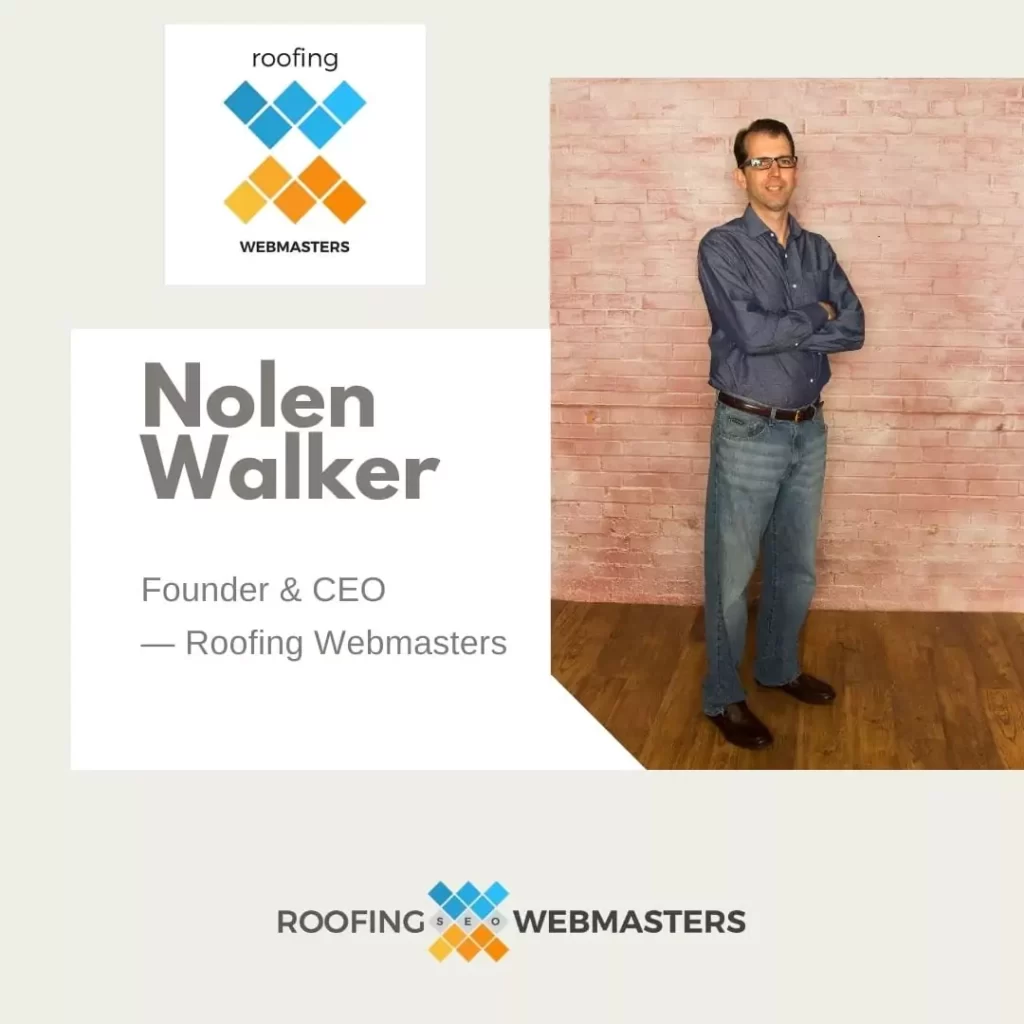
Over the past decade-plus running Roofing Webmasters, those principles have powered my company to develop a unique SEO strategy for roofing companies, resulting in thousands of roofing clients.
You can see some of those below:
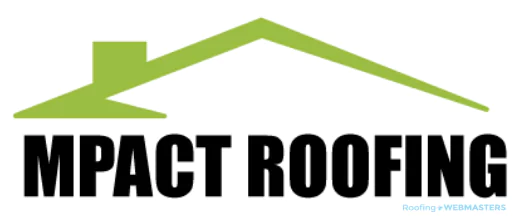
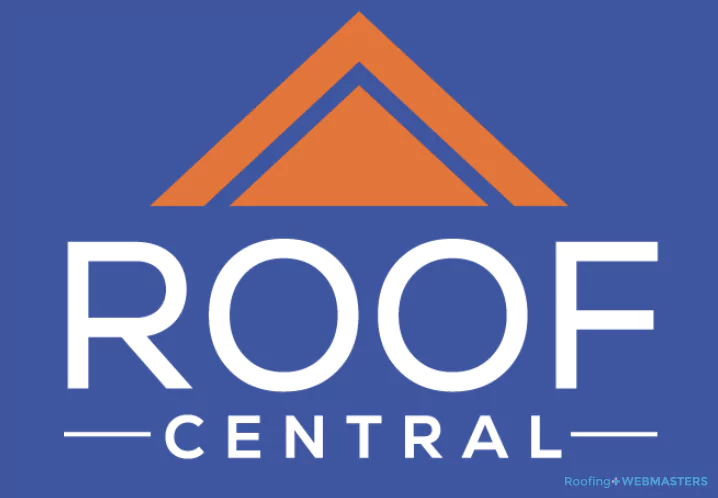
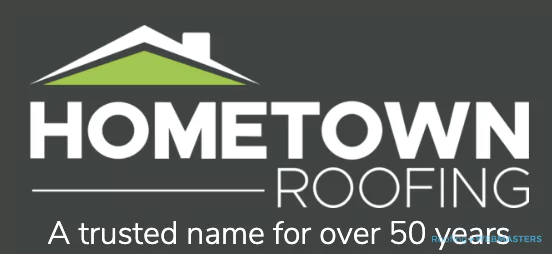
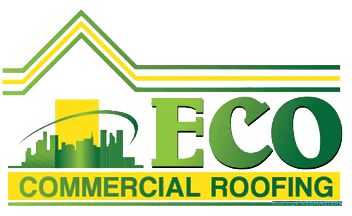
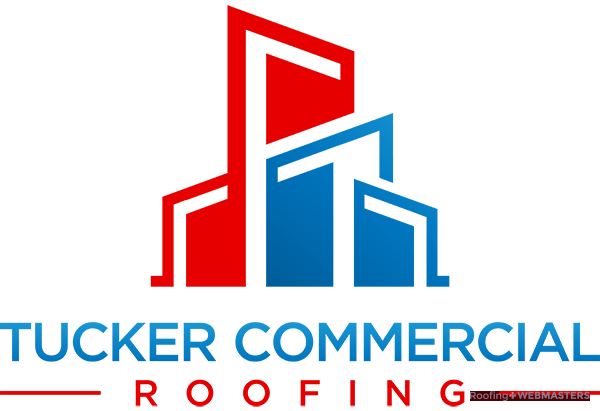
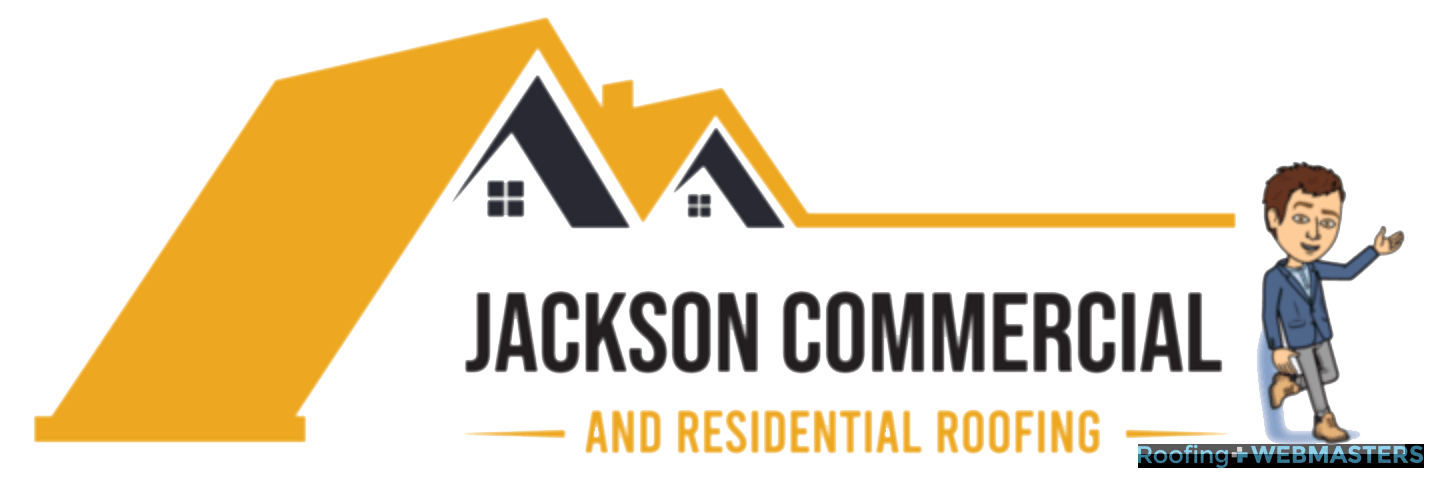
While I am always open to working with new roofing clients throughout the United States, I owe it to the roofing industry to share my decade-plus of expertise free of charge.
The roofing industry has given me so much personally that I owe it to all of you to provide free value to the people who deserve it most, the hardworking roofers of the USA.
I believe in something called the ripple effect, where this guide may spur the next great marketing campaign for local roofers and help them avoid the pitfalls of the increasingly dishonest marketing industry.
This guide will outline search engine optimization (SEO) and how to rank your website on search engines like Google. I’m not going to BS you or patronize your company or marketing.
In this Roofing SEO guide, you will discover:
- What SEO is, and why it is essential
- Best strategies for keyword research and optimization
- Best strategy for on-page SEO
- Best strategy for technical SEO
- How to earn high-quality backlinks from credible sources
- How long SEO takes to start working
- How to track, measure, and analyze SEO performance
- How to use DataPins to increase organic traffic 25x
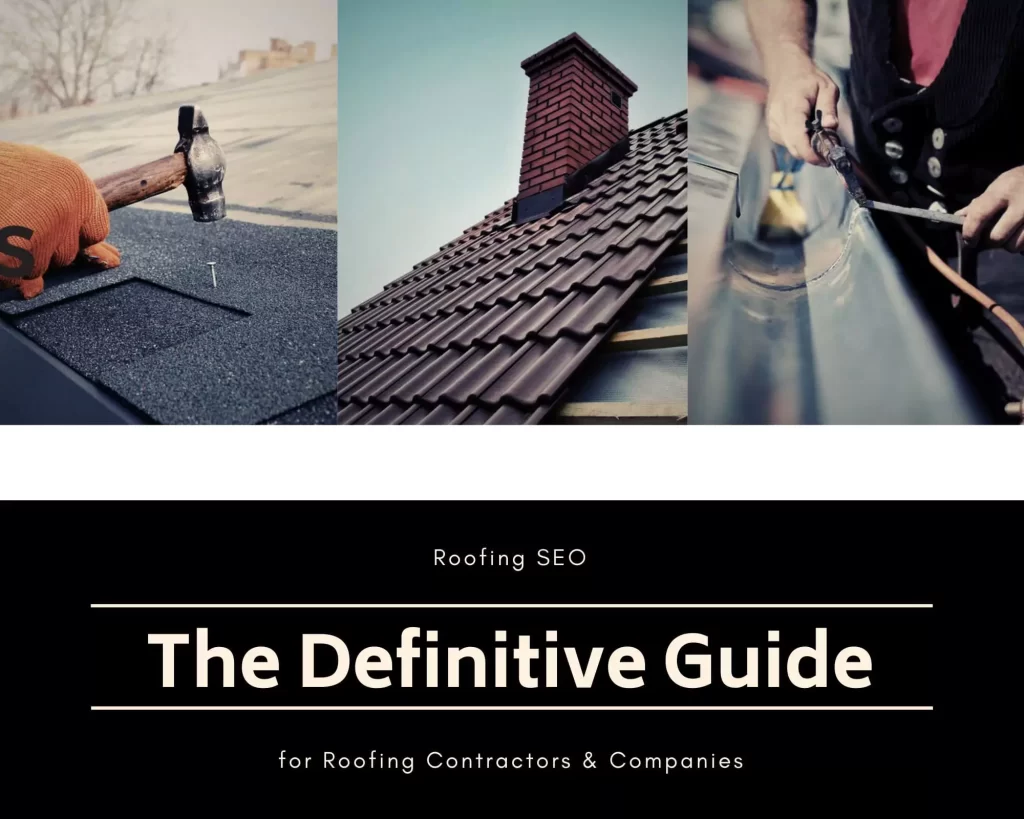
SEO is a Learning Process for Roofers
After completing this guide, you will better understand SEO for roofing companies, its purpose, and how to use it to generate high-quality roofing leads.
In addition, you will have the tools to rank your website for thousands of keywords on Google and other search engines.
What is Roofing SEO?
SEO is the process of refining digital content to rank higher on Google search results for industry-relevant keywords. Search engine optimization (SEO) can include tasks like title tag editing, keyword placement, internal and external link-building, and website enhancement.
SEO can apply to an official roofing company website, Google Business Profile, and other online entities. Any task performed to increase organic search rankings, impressions, or clicks is a form of search optimization.
Why is SEO Important for Roofing Companies?
Let’s say you own and operate a roofing company in Lubbock, TX. Ranking #1 on search results for “roof repair in Lubbock, TX” and other similar terms will drive relevant consumers to your business.
Whether they find your Google Maps listing on the Local 3 Pack or locate your roofing company website in traditional organic results, they discover your roofing company name, address, and phone number.
With that information, they can now contact you directly. In short, higher rankings ultimately produce increased lead generation and sales, which is what every roofer wants.

A successful digital marketing strategy goes beyond the rankings themselves. For example, once a visitor enters your website or views your listing, you want to make it as easy as possible for them to contact you. Not every website visitor becomes a lead, but you can improve the conversion rates.
Each service requires clear explanations, so prospective customers can quickly determine that you provide what they want when visiting your site for the first time. These and similar tasks form the conversion rate optimization process (more on that later).
SEO Strategy: The Planning Stage
Search engine optimization (SEO) is not an as-you-go process. A well-laid, detailed strategy is essential for SEO to work properly. Keyword research provides the foundation of SEO strategy.
First, roofing contractors must identify terms that attract the most relevant consumers to their website and other digital assets.
Your business should note each keyword’s search volume and competition level—tools like Moz, SEMRush, and UberSuggest provide volume metrics.
Choosing the right keywords benefits all your subsequent digital marketing activities, such as developing a URL hierarchy, writing content, and executing on-page SEO. In other words, you must nail your keyword selection.
Keywords and search queries aren’t just abstract concepts floating out there in space. In many ways, they represent your target customers.
That’s why keyword research tasks should be calculated and intentional. If you run a roofing company in Hartford, CT, you won’t want clicks from people in New York City.
National Keywords
Local websites aren’t competing against everyone in the country for the same term. So high-volume keywords like roofer, roofing company, roofing services, etc., depend on the searcher’s location.
Before starting more extensive keyword research, every roofer should know the top roofing keywords. These terms are the basis of your overall strategy.
They also inspire ideas for long-tail keywords that will be even more relevant to your local business and help you generate the right kinds of roofing leads.
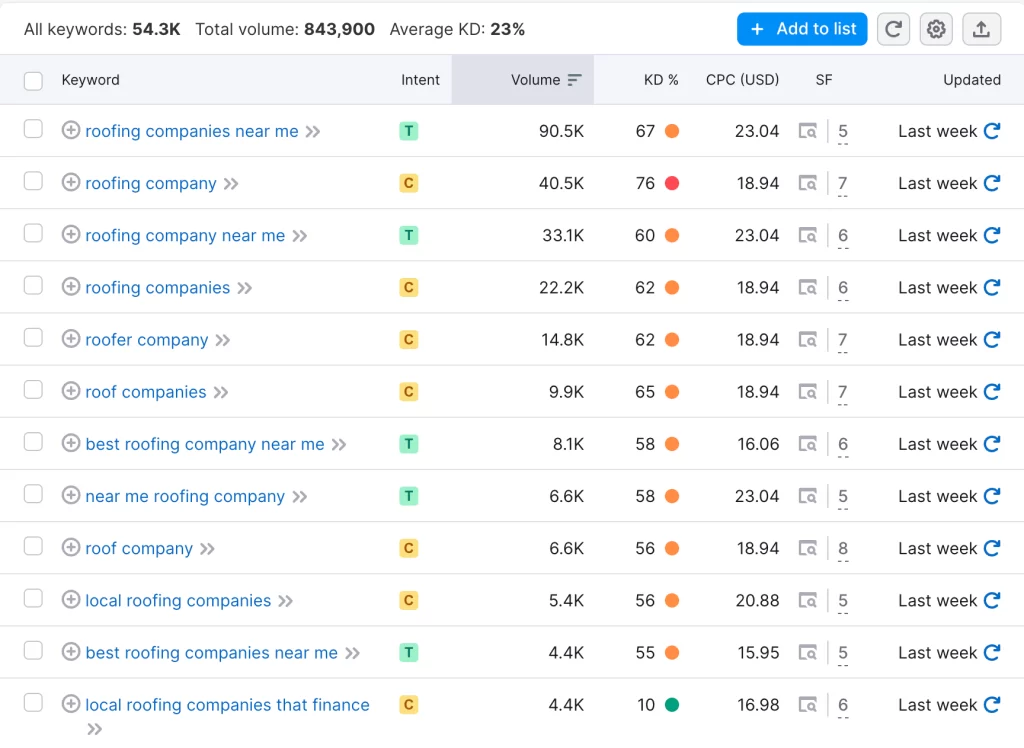
Local Keywords
When it comes to connecting with people in your community, the most optimal keywords include references to the target service area. The keyword “roof repair” shows a consistently high volume throughout the United States.
If your roofing company serves Atlanta, GA, your keyword would be “roof repair Atlanta” or “Atlanta roof repair.” In other words, you want the keyword + location to create a local keyword.
Many of the tools previously mentioned (Moz, SEMrush, etc.) can show you the volume of local keywords. For example, according to Moz, “roof repair Atlanta” has a search volume of 11-50 and, therefore, would be a better term to target than “Atlanta roof repair,” which has a volume of 0-10.
Using the city name instead of “near me” ensures that you target explicit queries rather than implicit queries, which can help you outrank competitors who fail to do so. With this in mind, your traditional on-page SEO (meta, title, headers, etc.), “roof repair Atlanta” will be a valuable search term.
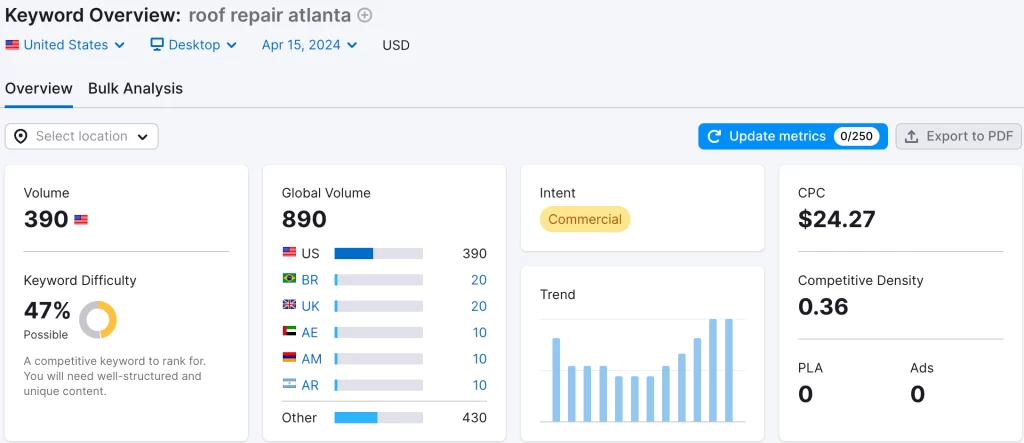
Service Keywords
The most successful roofing websites use interior pages to describe more specific services their company offers. Like your homepage, these internal pages should intentionally target keywords you want to rank.
Let’s say your roofing company provides a modified bitumen roof installation. You’d want to research the volume for terms like “modified bitumen roofing services” and “modified bitumen flat roof installation.” Once again, you will want to add the location term to make it long tail.
The keyword for a roofing company in Louisville, KY, would look like “modified bitumen flat roof installation Louisville.”
With such a long-tail keyword, you’d have a significant chance of ranking in the top 5 on search results for that query. If you execute it really well, you might even score the #1 placement!
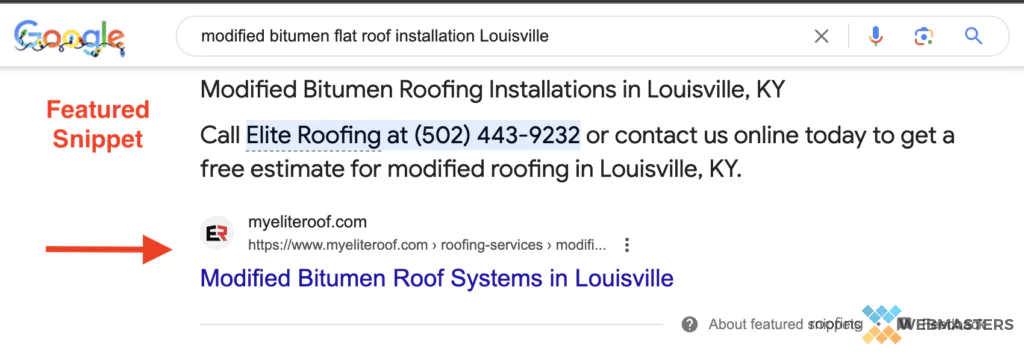
URL Structure & Hierarchy
Once you research and identify the best keywords for your roofing company, you can then construct a URL hierarchy. In simpler terms, you’re building a map for how your pages will be organized. Every website has a homepage, and most have an About Us and Contact Us page as well.
The structure of the site and how deep it goes separates roofing websites from each other.
Your main service pages are at the top of the URL hierarchy, also known as top-level pages or “parent” pages. For larger roofing companies providing both residential and commercial services, those two main categories would each serve as a parent page. The URL for these pages would look something like this…
www.yourroofingwebsite.com/residential-roofing/
www.yourroofingwebsite.com/commerciall-roofing/
Under those main pages would be more specific, lower-level or “child” pages.
“Commercial Roof Replacement,” for instance, would be a child page of Commercial Roofing, while “Residential Roof Replacement” would be a child page of Residential Roofing. In the URL, a child page would look like this…
www.yourroofingwebsite.com/residential-roofing/residential-roof-replacement/
Child pages can be further divided into sub-levels as needed. If you have a parent page for Commercial Roofing and a child page for flat roofing, you can have yet another child page beneath that for something (like modified bitumen).
You should not go more than three pages deep in a hierarchy; however, longer URLs are difficult for Google to crawl and, therefore, less likely to rank well on SERPs.
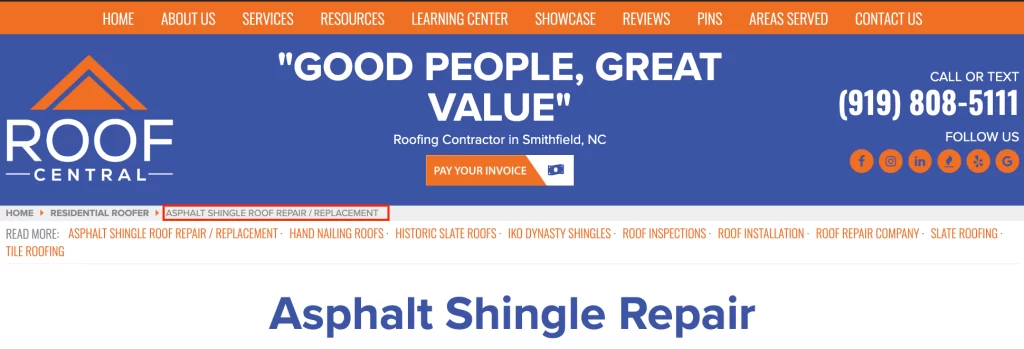
Images & Videos
User experience plays a key part in a website’s performance. That’s why images and videos naturally fit well in most SEO strategies. You should designate certain images for specific pages to prevent duplication and accidental mismatches.
The best images are always original; they are shots of your actual company, facility, employees, equipment, and transportation. The worst images are stock photos, which are the last resort for roofers without photos of themselves.
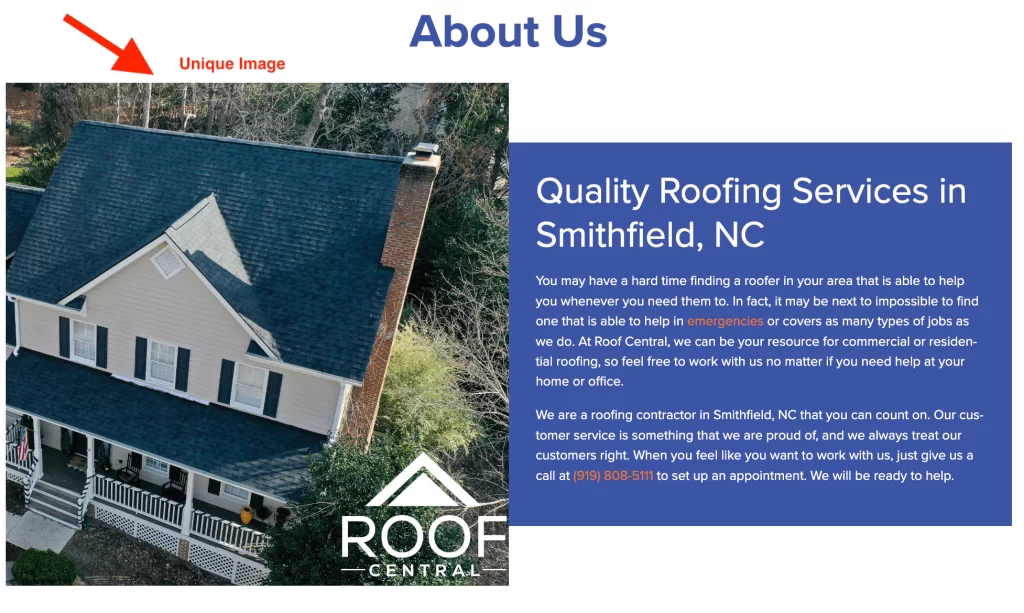
Search Engine Optimization: The Implementation Stage
SEO is a massive-scale undertaking spread across multiple activities. You shouldn’t expect to understand every optimization method utilized on the web at first glance. Several concepts may seem foreign to you, at least initially.
If you’re wondering whether or not a specific activity is part of optimization, remember this:
Any activity that influences rankings can be considered part of SEO.
Critical planning and research make it easier to implement your SEO strategy smoothly. The better the overall picture you create in advance, the easier it will be to maintain a cohesive plan as you arrange your website, listings, etc.
Again, SEO is not an as-you-go process. As the saying goes, “Failure to plan is planning to fail.”
Custom Design
When visitors arrive at your roofing website, it takes less than a second for them to form a subconscious impression of your brand. This decision instructs whether or not they stay on your website or move on to the next result on the previous SERP.
Several factors subtly influence a user’s experience. Some are less tangible, like aesthetic taste, while others are more easily defined, like resolution.
Aside from a pleasant appearance, users also crave simple navigation, clear and convincing calls to action, clean graphics, and instructive menus. They want to feel confident about the company’s reputation and leave with an impression of trust and reliability.
Websites with obsolete designs are more likely to be perceived as scams. If your business page looks like it was created with DreamWeaver in 2003, Google will remove it from the top of search rankings.
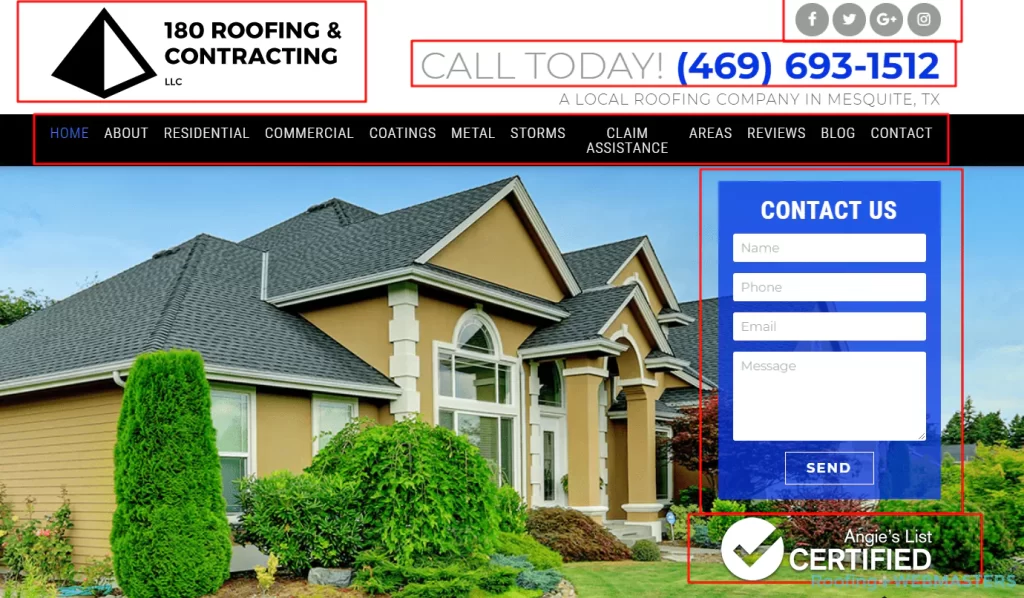
Contact Information
The most important part of local SEO for roofing companies is contact information. NAP visibility is paramount since the lead conversion funnel predates the visitor’s call to action.
For those unfamiliar with the acronym, “NAP” stands for “name, address, and phone number. “ That information should be clearly evident on each website page (especially the homepage).
Your NAP data should be accurate and consistent across every single page. A mistake with your company address or phone number can result in a substantial loss of leads.
Worse yet, it can initiate a snowball effect that drops your rankings because of poor user experience and decreasing trust. Even a small error can have large implications for a roofing contractor.
For this reason, checking your phone numbers on each page is a good habit to get into.
Ensure your NAP information is consistent across off-site listings like the Better Business Bureau!

Call To Action
A call to action (CTA) is an element of your site that directs visitors to perform a given action, such as calling your office. Your NAP data often accompanies it.
Strong calls to action provide a compelling incentive to your visitors, encouraging them to call your number or complete some other kind of action that gets them inside your sales funnel.
CTAs vary significantly in complexity and design. Some urge users to call your number from their mobile device (e.g., a clickable phone number button), while more complex CTAs cast a less demonstrative hook (e.g., a “Free SEO Audit” button).
CTAs have different goals and functions, too. A free SEO audit offer casts a broader net, targeting uncommitted prospects at the start of the sales funnel.
This type of offer may not convert people as effectively as direct phone calls, but it at least puts them on your radar and generates some buzz for your local roofing company.
Phone number links are best for on-site conversions, especially for mobile visitors who can click to call.
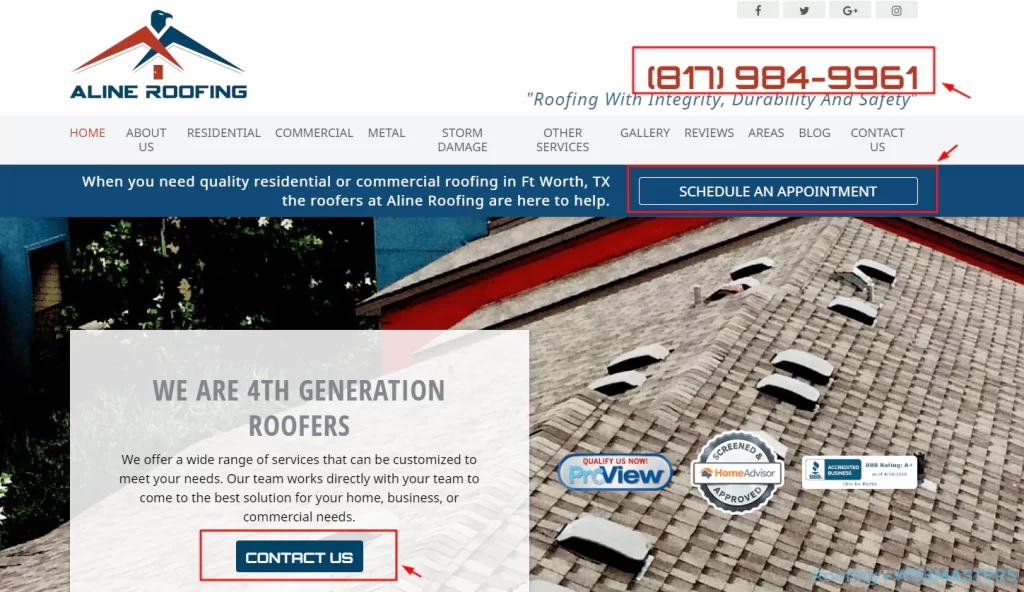
Website Personalization
Nothing establishes trust faster than personalization. Your roofing company website should display images of your roofing company. It doesn’t matter who takes the photos.
It can be as simple as snapping some photos of your employees and trucks with your smartphone device. If you like, hire a professional photographer to follow your crew for the day.
You have many options to personalize your website. Your homepage deserves original photos, most of all. Prospective customers want to know who they’re dealing with.
Effective marketing speaks directly to the consumer. Ordinary stock photos won’t convey trust; they limit website conversion rates.
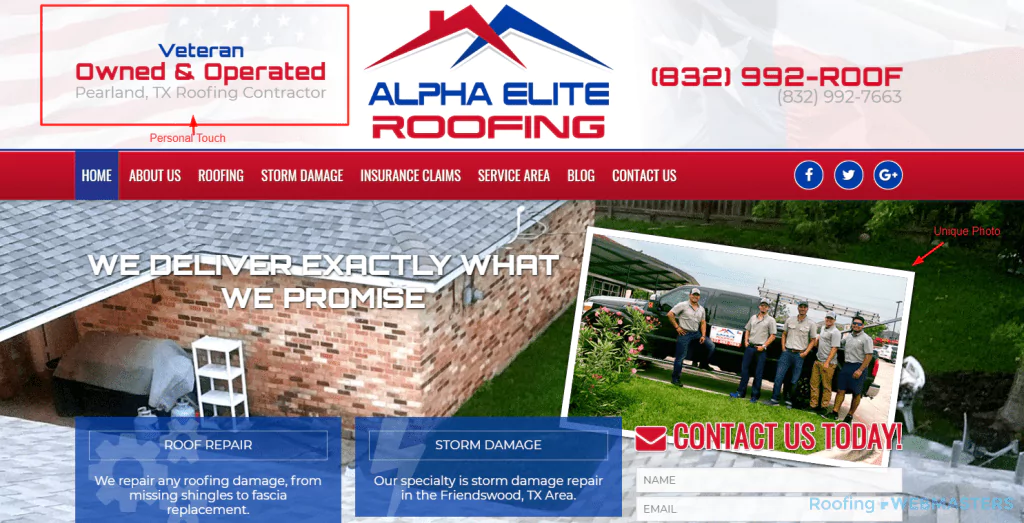
Badges & Accolades
Personalized photos of your business create trust. Badges and accolades further build that confidence in your brand’s reputation. If your business has ever received any type of certification, it probably comes with a digital badge for use on your website.
Bages can come from national organizations like the Better Business Bureau or local ones like your regional Chamber of Commerce. Other ideas for badges include newspapers and news websites on which you’ve been featured.
Have you ever been interviewed by a local reporter? If so, you can absolutely add a newspaper icon in your website’s “As Seen On” section.
Consider prestigious certifications like these below when adorning your website:

Multimedia Content
Images are great, but videos are even better. If you have video footage of some of your roofing jobs, perhaps before and after shots, they can really take your website to the next level.
Video is the fastest-growing content asset in the world, and very few roofers feature them on their company websites. This represents a market inefficiency for roofing contractors to capitalize on simply by taking the time to produce videos.
This footage can be captured with a basic smartphone—there is no need for a professional videographer! The ideal strategy is to upload your video to YouTube and then embed the code from that video into your website’s HTML.
This way, you can rank on both video search engine results and YouTube while enhancing your company website’s user-friendliness. Even audio-only podcasts, which can be syndicated through Apple or Spotify, can quickly increase brand appeal.
Video content from YouTube can appear directly on Google SERPs, increasing its SEO value exponentially.
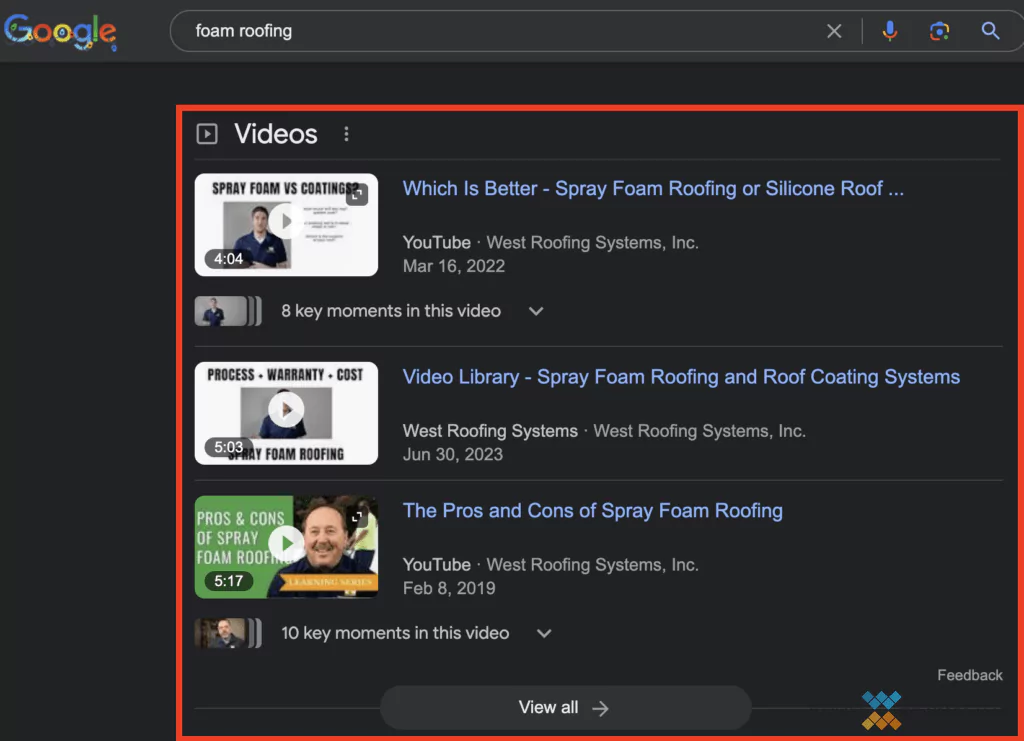
Showcase Testimonials
Most roofers understand the importance of Google Reviews, but did you know that showcasing testimonials on your homepage influences SEO results, too?
For one, reviews are user-generated content, which Google loves. Secondly, verifiable reviews showcased on your company’s homepage promote an enhanced user experience, promoting visitor trust.
Some plugins allow you to showcase reviews on your homepage. One of them is DataPins, which actually helps roofers generate more reviews on GBP and Facebook while showcasing the ones they already have directly on their website.
A plugin like DataPins offers numerous SEO benefits for roofers because it combines user content, trust, and brand awareness.

Mobile Optimization
Most visitors access websites through mobile devices. With this knowledge, every roofer should ensure their site is mobile-optimized.
With the onset of Google’s mobile-first index update, they’ve made it clear that pages with mobile appeal will be given priority on search results.
There’s no shortage of factors that can enhance a mobile webpage; the same is true of factors that can ruin them. Enhancements include responsive design, clean navigation, and clickable calls to action.
Negative factors include viewport distortion, slow loading times, and image misalignment. As you might imagine, mobile users’ attention spans are exceedingly short, and little can be done to retrieve it once it has passed.
Consider if the mobile user’s needs are met when clicking on your search result from their smartphone.
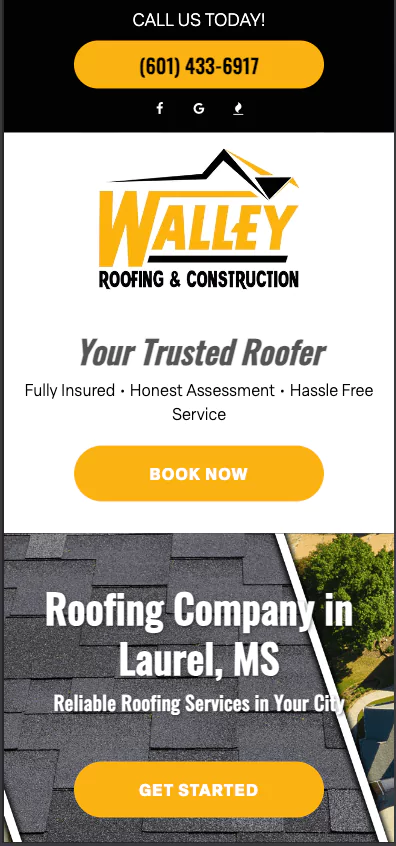
Google Analytics Tracking
Google Analytics has long been the most powerful tool for tracking SEO performance for roofing websites as it measures traffic from various sources, from Google Organic to social media referrals.
However, a recent change to Google Analytics, in the form of GA4, has made the interface less user-friendly.
Google Search Console is now the most user-friendly tool for tracking SEO performance. However, Search Console is restricted to traffic from Google Organic Search, which means it does not account for traffic from other search engines (like Bing) or other sources (like referrals).
With this in mind, it’s essential to continue to track your website through Google Analytics 4, even if the analysis is less enjoyable.
The best tool Google has to offer roofing companies is Google Analytics 4. It provides measurable results of your website’s performance and can produce reports to help improve weaknesses and capitalize on strengths.
Perhaps the most essential feature of GA4 is the Acquisition Report.
This report tells webmasters how many visits their website gets daily, weekly, monthly, and yearly, including a breakdown of where the clicks are coming from (i.e., organic, direct, referral, etc.)
Although Analytics is somewhat limited in revealing very few of the exact search queries that lead to your clicks, simple comparative analysis can help you deduce precisely what is driving your traffic and instruct ways to improve.
If you see sudden shifts in your traffic, either up or down, you can diagnose issues and address website needs.
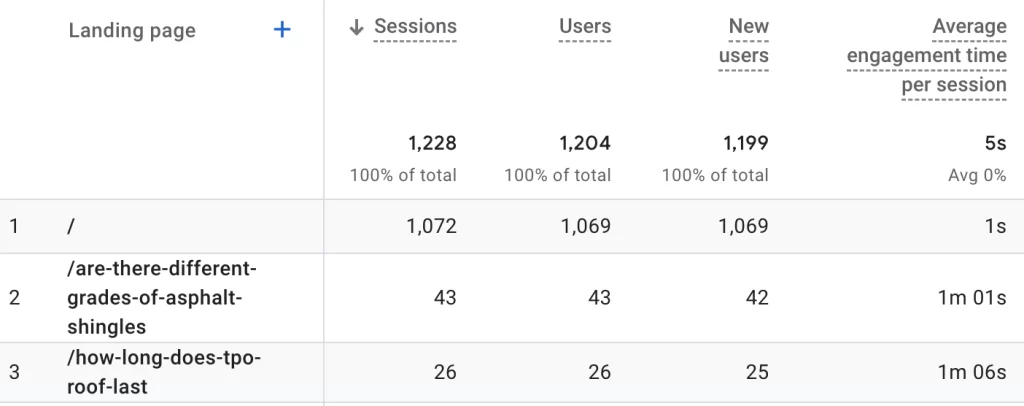
SSL Security
Most reputable browsers warn users when they are on a website that is not secure, meaning one with http:// instead of https://. If you are unfamiliar with SSL security, it is a security protocol that protects data transfers over the web.
Sites that have it enabled are https:// addresses, which is precisely what you’ll want your site to display.
SSL is indicative of trust and makes for a superior user journey. While roofers rarely sell products online (e-commerce), they still want to create the optics of strong security.
Because it can influence a user’s perception of your site, SSL must be considered, at the very least, an indirect SEO ranking factor for roofers.

Source: https://www.immuniweb.com/ssl/
Local SEO for Roofing Companies
Local roofers rely heavily on Google Business Profile and Maps to help their business rank on local search results. The address listed on your homepage (something we discussed previously) should exactly match the one listed on your Google Business Profile listing, which will, in turn, appear on Google Maps.
The goal is to appear in the Local Map Pack a snippet of the top 3 GBP listings in a particular service area. Of course, you’ll also want to rank on traditional organic results for queries involving your target keywords and locations.
Remember that you should only target cities you can service and that the closer your address is to the target area, the more likely you are to rank for the term, especially on Google Maps.
Some companies are large enough to require multi-location SEO. This is only true for roofers with multiple legitimate business locations and verifiable addresses. Since Google Business Profile listings are verified through postcard confirmation, any kind of illegitimate address is prohibited.
These include virtual offices, PO boxes, and anything that cannot be considered a place of business. Google Business Profile recently altered its requirements for businesses that operate out of a house.
If your roofing business address is also your residence, GBP asks you not to include the address itself on the listing. Still, you’ll need to verify that address privately using either the postcard or video verification method.
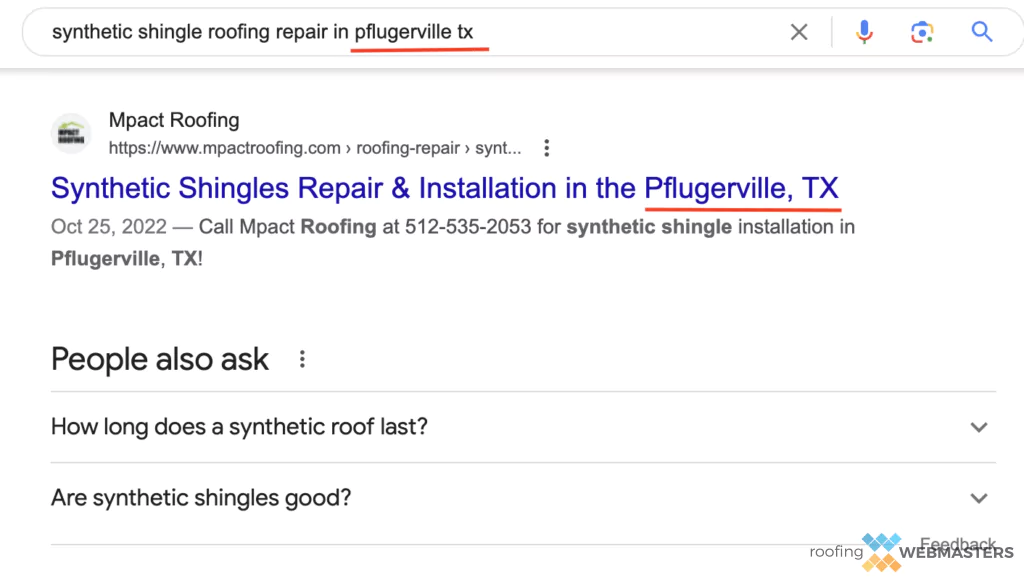
Local Business Citations
Most roofing contractors have heard of directories like Angi’ and HomeAdvisor, which are platforms for NAP citations. There are countless directories on which to cite your local roofing business.
From niche directories like Angie’s List and HomeAdvisor to more generalized platforms like Yelp and BBB. Some of these directories offer premium services, which you should consider separate from the citation itself.
The goal is to claim all of your free citations and ensure the accuracy of the existing ones. Sometimes, you’ll find that citations that you never manually created exist.
This can be from data mining sources like Acxiom, which pulls your company info from public records and then sells it to major data distributors.
Tools like Whitespark and Moz Local can help you claim and correct citations.
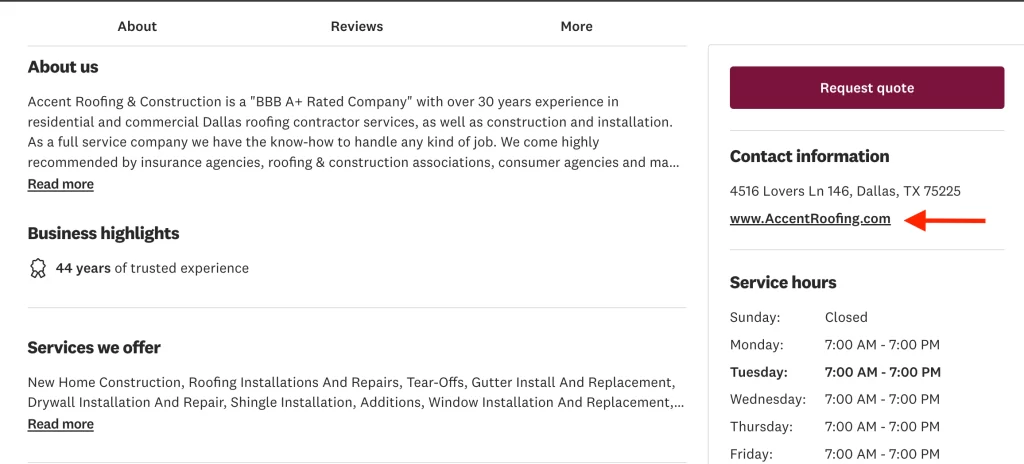
NAP Consistency
In congruence with claiming business citations on local business directories, you’ll want to ensure their consistency simultaneously. Tools previously mentioned, like Whitespark and Moz Local, can help streamline that process, especially for tenured businesses with thousands and thousands of citations.
Of course, accuracy is the most critical factor, but consistency also matters. Even if your address uses a suffix that varies in spelling, you want it to be identical on every citation. For this reason, choose a singular suffix spelling and stick with it for every citation.
Optimizing your citations ensures your roofing company sends. as many consistent signals to search engines as possible.
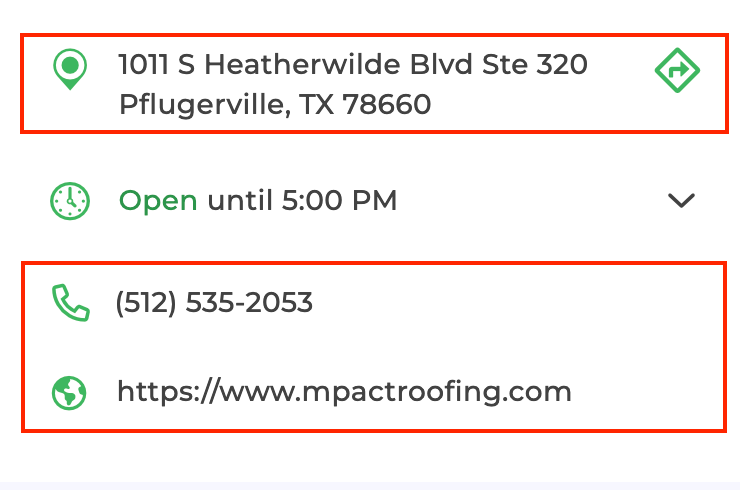
Google Business Profile Optimization
Google Business Profile (formerly Google My Business) is a directory, but it is also so much more than that. It is the central hub of your entire local SEO strategy.
Not only should your GBP listing be claimed, verified, and accurate, but it should also be optimized for conversion.
I spoke previously about website conversions, but GBP listings can also be a significant source of leads. Optimizing your listing with company photos, Google posts, and Q&A content is the best way to increase conversions.
Furthermore, you want to include the Call Now button so mobile users can click straight from their mobile devices and connect with you through a call.
A Google Business Profile is a roofing company’s most critical aspect of Local SEO.
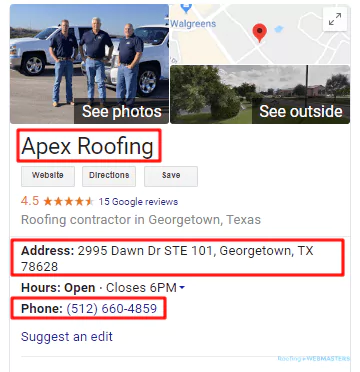
City Pages
Even roofers with one location often serve multiple cities within a radius. To reach those cities, you must create unique and informative city pages optimized for their respective locations.
I strongly discourage the mass production of city or county pages, a tactic known as “spinning.” However, the onset of ChatGPT has supercharged this technique, which can produce 100% unique city pages with a couple of prompts.
While using ChatGPT to produce your city pages is tempting, its long-term impact on your website is unknown. My agency, Roofing Webmasters, has run tests showing that some websites are penalized for using this content while others are not.
As a general long-term strategy, you should avoid any tactic that introduces a high level of risk to sustainable success.
Some roofing contractors use the software to mass-produce pages for every city, town, and county within their general area. You might use tools like ChatGPT or Jasper to create this content, but Google can detect it.
Search engines have smartened up to this pitiful concept and penalized websites that engage in it.
City pages should be unique and specific to the location they are optimizing for rather than a re-hashed duplication of another page.
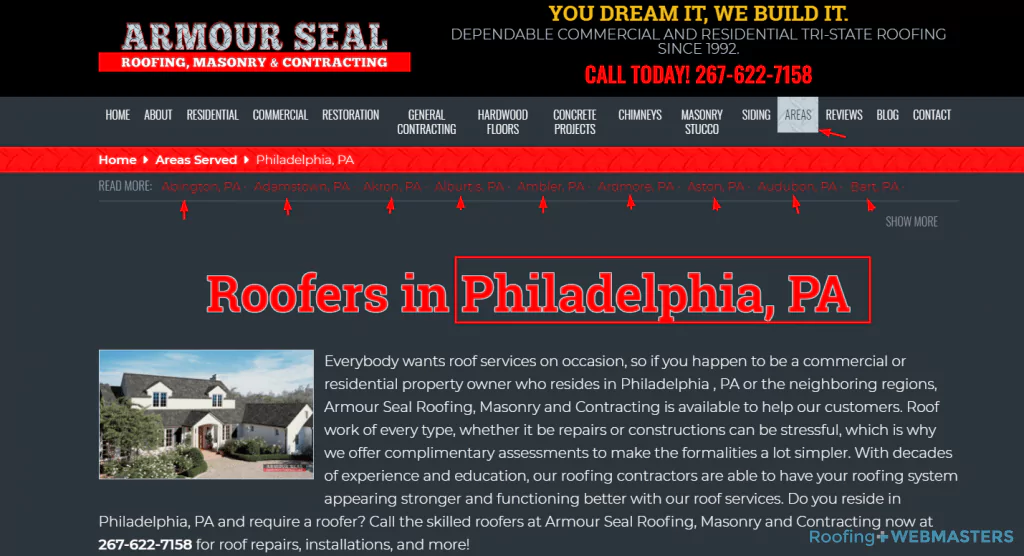
On-Page SEO for Roofing
The general public’s most widely understood optimization components are methods known in totality as on-page SEO. They include altering title tags, meta descriptions, header tags, URL slugs, and content writing.
The SEO strategy cited earlier will frequently be used with on-page optimization.
You will take the keywords chosen in your research phase and implement them onto your web pages in various formats.
Most roofers who have some knowledge of digital marketing associate SEO with on-page methods, and rightfully so. They are the most straightforward tasks and the ones that are most frequently discussed in the mainstream.
SEO takes time and patience but has a lasting influence. When you optimize a page for search, you seek more than short-term gratification; you seek long-term equity.
Pages you create and optimize today could serve your business well for decades to come. As they gain tenure and trust, they will also gain authority.
The better your pages are optimized, the higher they rank, and the more they will venture into other forms of your roofing SEO strategy, including off-site, local, and technical SEO. Knowing this, it is crucial to be precise when performing on-page tasks.
Keyword Placement
During on-page optimization, your keyword strategy will be deployed in various ways. From title tags to meta descriptions and the body content in between, you should use keywords properly by placing them in the most opportunistic spots.
The left-hand side of any of the elements mentioned is typically that spot. But be careful; you want to avoid redundancy, and you want content to enhance the reading experience, not hinder it.
So if your keyword is roof replacement in “city,” your title could be:
Roof Replacement in City, your H1 could be Roof Replacement Services
Meanwhile, your meta description could read:
Roof Replacement Services From [Company Name] Are Affordable, Reliable, and Easy to Schedule. Residents of [City, State] Can Call [###-###-####] To Schedule Their Services Today!
You now have the keyword in three on-page elements without any of them sounding spam-like or misleading. You should follow suit for H2 and H3 tags, image alt text, and the paragraph content on the page.
One thing to remember at all times is never stuff keywords. Only use the term within your paragraphs when it makes sense to the reader.
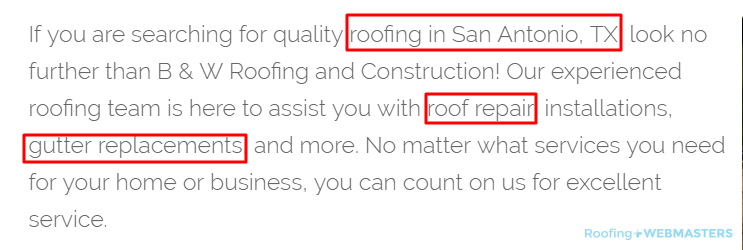
Title Tags
A page’s title tag or SEO title appears in search results as the clickable portion of the result. You want keyword relevance, of course, but you also want something that urges people to click.
When a user clicks on a page, it increases its click-through rate (CTR), which signals to Google that people like what they see from your initial result.
You want an appealing title tag that represents your website and services. You don’t want to mislead anybody because they will exit immediately if they feel like they’ve been swindled.
For local roofers, you won’t need anything too over the top within a title tag. It might be as simple as “Roofer in Pflugerville, TX | Schedule Your Roof Inspection Today.” Analytics will help you monitor the click-through rate, and you can adjust your title tag based on behavioral metrics.
Moz can help you preview a title tag to ensure it’s within the character limit for optimal presentation.

Meta Descriptions
The text underneath the title tag on a SERP result is known as the meta description. Depending on who you ask, the character limit is either 150-160 or 300.
Google temporarily changed how they showcase specific meta descriptions but have resorted to their original methodology.
Like the title, a meta description should appeal to the search engine user. It’s not quite as crucial because fewer people actually read it.
Still, it helps to have one instance of the keyword and an accurate depiction of what the user will find when they click through.
You can even include your phone number at the beginning of the meta description so that consumers can call you before entering the site.

Header Tags
Headings are important for formatting purposes, but research shows that they also matter for search rankings on a more direct level. There are several types of header tags. You have your H1, your H2, and your H3. Some websites even have H4s and H5s, depending on their style sheet.
The H1 header matters most for on-page SEO. It is essentially considered a subtitle on a given web page, so having your keyword within is ideal.
As I stated before, your H1 should never look spammy. The keyword must fit naturally within it and make sense within the page’s context.
H2s and H3s are more important for formatting than anything else. But as you should know, formatting enhances ease of use and positively impacts search rankings. It also serves as a great way to categorize sections of a page.

URL Slugs
The URL slug or the permalink is the section of a web address that appears on the right-hand side.
So if your website is myroofingcompany.com and your page is created as a lower-level page underneath a parent page like Residential Roofing, your URL Slug would be:
myroofingcompany.com/residential/enter-url-slug
What you fill in as the URL slug should be topically relevant, concise, and, if possible, include the keyword.
An example of a good URL slug for residential roof repair is:
myroofingcompany.com/residential/roof-repair.
You’ll notice how that reads better than an alternative like:
myroofingcompany.com/residential/residential-roof-repair
There’s less redundancy in the former example; the latter is harder for search engines to crawl and easier for your visitors to look at. URL slugs are also known as permalinks because they are permanent.
If you no longer need the page, you can implement a 301 redirect, which will auto-direct a user from that page to a newer update. Still, the permalink will remain intact.

Image Alt Text
An often overlooked on-page optimization factor is image alt text, which describes an image on your web page.
An image file should always be titled in lowercase letters with dashes for those who don’t know.
If you upload an image of your roofing truck, a suitable file name would be company-name-truck.jpg … or something to that effect. Once the image is uploaded and embedded into your content, you should fill out its Alt Text.
This is more or less a description of what the image is. So if it’s your truck, the Alt Text should be similar to the title: Company Name Truck. This is a small but effective task for on-page SEO.
Off-Site SEO for Roofing
If you’ve wondered why on-page SEO isn’t just called “SEO,” it’s because other kinds of optimization take place away from a website and its pages. These tasks are referred to as off-site SEO or sometimes off-page SEO. Regardless of which term you subscribe to, the concept is the same.
Google evaluates signals from external sources to judge your web presence in totality. A clear example of this is inbound linking. In fact, inbound links were the original measure of a website’s value and remain an important ranking factor today.
Although link building was once easy to manipulate, that is no longer true. Successful off-site optimization requires more work than it once did. For links to hold value, they must be relevant to the entity they link to.
A diet pills website that links to your roofing repair page will not do much to boost its value in the eyes of search engines. Links come in many forms, including social media platforms, business listing directories, and other websites.
Off-site SEO aims to expand brand awareness and develop a web presence over time.
Social Media
A company website is not the only representation of your roofing business online. Roofers can leverage free social platforms like Facebook, Instagram, X, LinkedIn, and YouTube to expand brand awareness.
Since these web entities exist exclusively from your main site, they are considered “off-site” and, therefore, part of an off-site SEO strategy.
Often, on and off-page methods can be merged with social media. For instance, sharing a pin (a recent job) on your Facebook feed contributes to both on and off-page elements.
Moz also considers social signals a local ranking factor, so social media activity alone will likely enhance one’s overall development.
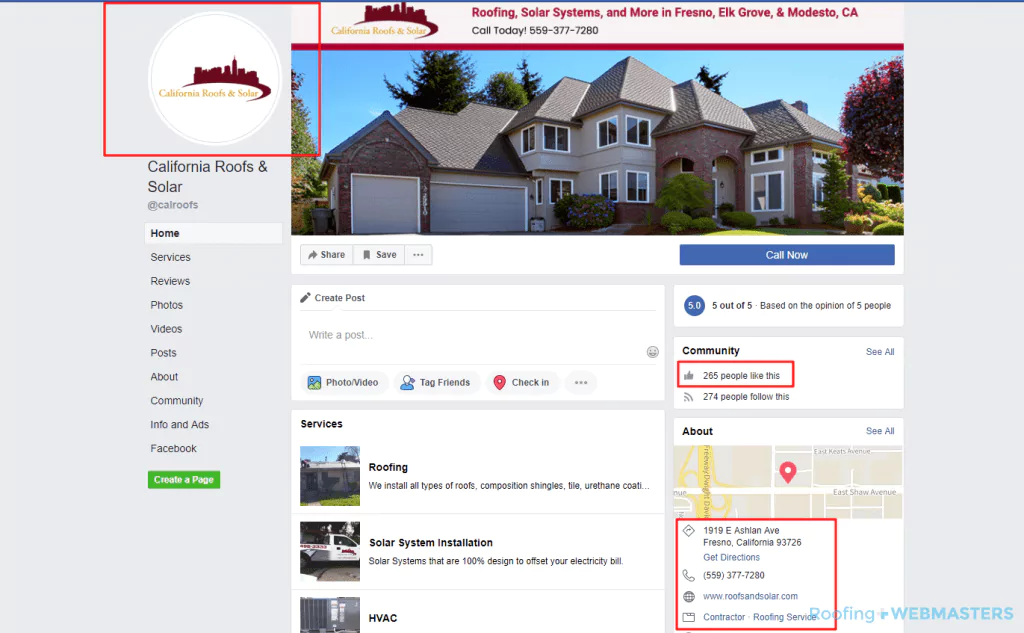
Link Building
There are so many ways to build inbound links to your website; some help, and some hurt. Antiquated tactics, such as buying links from blog comments or PBNs, are frowned upon by Google.
While purchased links won’t necessarily cause penalization, their zero-sum value contributes to resource depletion. Better ways to build links involve networking with other web entities or personalities, including marketing influencers.
Blogger outreach is a way to pitch your website’s relevance for inclusion in a guest post on another domain. The more relevant the domain is to your roofing company, the more link juice will navigate towards it.
Earning links naturally remains the safest and most effective strategy, and writing great content that ranks is the best way to achieve that goal.
Tools like Moz, Majestic, and others can track inbound links from other websites.
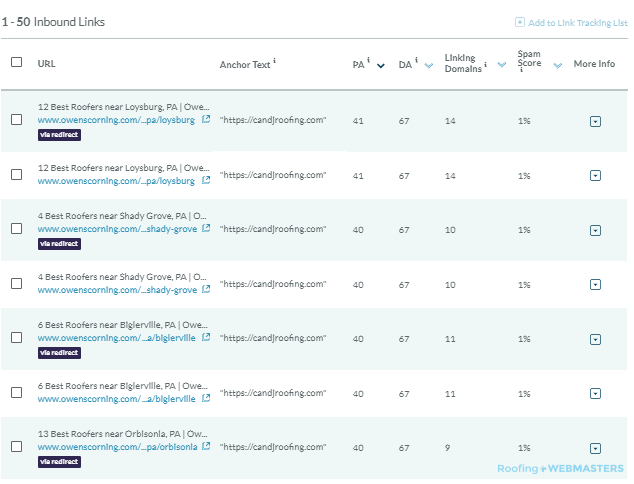
Technical SEO for Roofing Contractors
Websites earn rankings not just from on-page optimization or off-site link building but also from technical optimization.
Technical SEO is executed behind the scenes on the back end of a website. It involves refining HTML & CSS coding and implementing microdata tags known as schema markup.
Schema helps search engines parcel data and most appropriately rank your website based on its subject matter and relevancy. Technical optimization also involves issues like 301 redirection, XML sitemaps, and site speed optimization.
Technical optimization can be the most foreign concept for roofers without knowledge of computer programming. To the average eye, HTML and CSS look like gibberish. However, Google views the code far differently than an internet user would.
To Google, the technical aspects of a website are essential when determining its inherent value. Most of all, they contribute to driving relevant users to websites that will address their needs.
301 Redirects
When a webpage is no longer valuable to visitors, it should be redirected to a more relevant page. You don’t want to delete a page outright because it has already been indexed on search results.
Deleting a page can cause significant problems for your website, frustrate would-be visitors, and harm your SEO efforts.
With a 301 redirect, the URL destination will remain indexed but funnel the users who click through to a superior page without them even realizing what happened.

XML Sitemaps
Every website needs an XML sitemap to encourage Google to index every page. Since not all pages will be internal links from the homepage, you still want them to be indexed on search engines.
Sitemaps are particularly useful for larger websites, as Google has more difficulty crawling the number of pages on sites like these.
Like with other forms of technical optimization, the goal is to make Google’s crawling process as simple as possible.
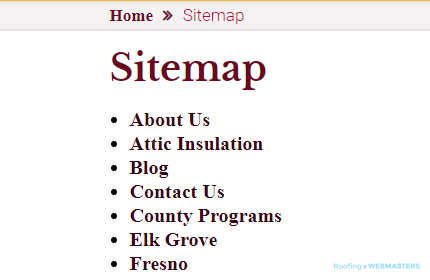
Site Speed Optimization
Attention spans are shorter than ever, and a site’s loading speed is critical to roofing websites. Clean code accelerates loading speeds, while obtrusive elements like JavaScript can slow it down.
A professional designer or programmer can perform several tasks on a site’s back end to ensure its loading speeds are as fast as possible.
This is important for search engine optimization because users don’t want to wait more than 1 second for a page to load.
If they’re forced to, they are likely to move on to the next result, which increases your bounce rate (the rate at which users exit your website immediately after entrance) and potentially decreases your ranking.
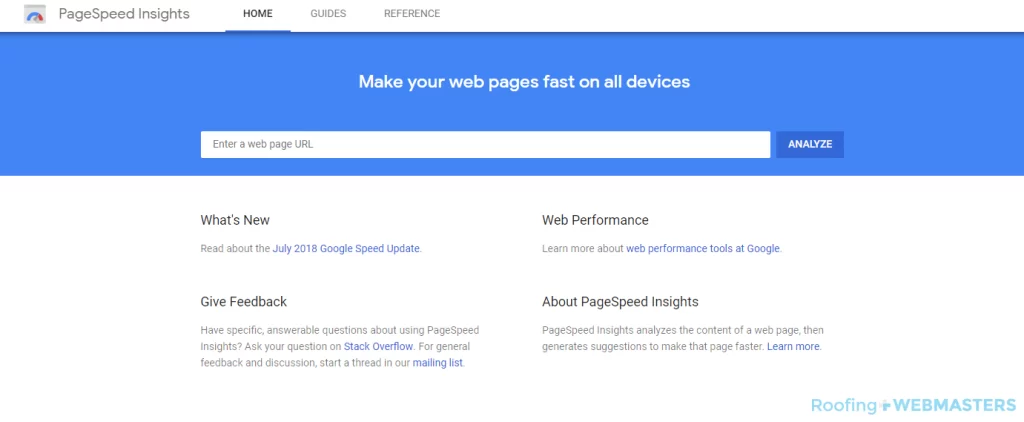
Targeting Specialized Roofing Services With SEO
Depending on your market, quickly ranking for terms like “roofing services” or “roofing company” is unrealistic. However, specializing in a specific roofing system or service can differentiate your company and earn more clicks early in the process.
This strategy empowers you to stand out and be confident in your SEO approach.
Keywords that include specialized services have lower competition on Google Maps and traditional organic search results, which allows roofing companies that incorporate these services into their SEO strategy to rank for these terms quickly.
For example, many of my clients target metal roofing, commercial roofing, tile roofing, and roof coatings early in their SEO process.
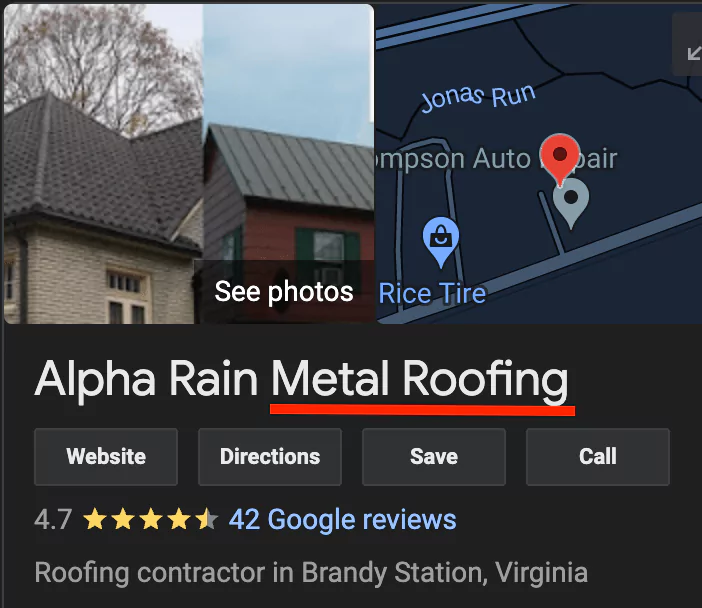
Metal Roofing
Terms like metal roofing company and metal roof repair are valuable for ranking your company on Google search. Creating a page for “metal roofing” is not enough, as Google favors companies that incorporate this specialty into their brand.
For example, including “metal” in your company name lets you target and convert customers seeking metal roofing services. Having metal in your official business name also gives you an SEO advantage on both Google Maps and Google Search.
Commercial Roofing
Unlike metal, commercial roofing is a broad term that features a variety of subtopics, like TPO and EPDM roofing. While it’s not as granular as other specialized services, it allows your company to differentiate itself from traditional residential roofing companies.
Commercial roofing jobs are also higher-ticket projects, meaning the value of each commercial customer is more significant than that of your residential counterparts.
Like with metal, including commercials in your business name allows you to rank quickly on Google Maps and Google Search for commercial-related queries.
Tile Roofing
Some contractors prefer to stick to residential projects but still seek ways to differentiate their business from competitors. A great example of this is tile roofing, which is within the umbrella of a residential contractor but targets a specific sub-niche of consumers.
My agency has witnessed success in crafting a marketing strategy around tile roofing. Several of our clients have included tile within their business and have enjoyed fantastic results on Google Maps and Twitter for a sustained period.
Roof Coatings
If you find the commercial roofing niche too broad for your start-up company, drilling down to a sub-niche like roof coatings can prove valuable. This is especially true in densely populated areas that likely already have multiple commercial competitors.
As with tile roofing, my agency has helped companies focus on commercial roof coatings and implement “coatings” into their official business names.
Although users frequently search for “roof coatings,” there are also sub-topics within the coating umbrella, like silicone and polyurea coatings, around which you build additional content.
AI’s Impact on Roofing SEO Strategies
Artificial intelligence has already impacted SEO on multiple levels, both positively and negatively. While using AI in SEO practices requires nuanced discretion, it is important to embrace new technology rather than fight against it.
ChatGPT is the most user-friendly AI tool for SEO. Roofers can leverage ChatGPT in multiple ways to help with SEO. However, other use cases may harm SEO performance.
ChatGPT
ChatGPT is an Open AI tool for the public to utilize the large language model GPT. It sounds complex, but once you try the tool, it’s actually very user-friendly. ChatGPT can perform various SEO tasks, such as suggesting topics, optimizing title tags, and providing keyword ideas.
ChatGPT can also create full articles, blog posts, and YouTube descriptions for your content. However, publishing articles written entirely by ChatGPT is dangerous and may negatively impact rankings.
Google’s guidelines do not prohibit using AI to generate content, but they clearly stress the importance of creating content for human beings, not search engines.
Using ChatGPT to create SEO-friendly blog posts or service pages violates Google’s guidelines. That said, some text generated by ChatGPT is okay to use on your website as long as it helps your target audience complete their goals.
ChatGPT 4 can also create images, write code, and browse the web, making it an extremely powerful tool for research, brainstorming, and editing.
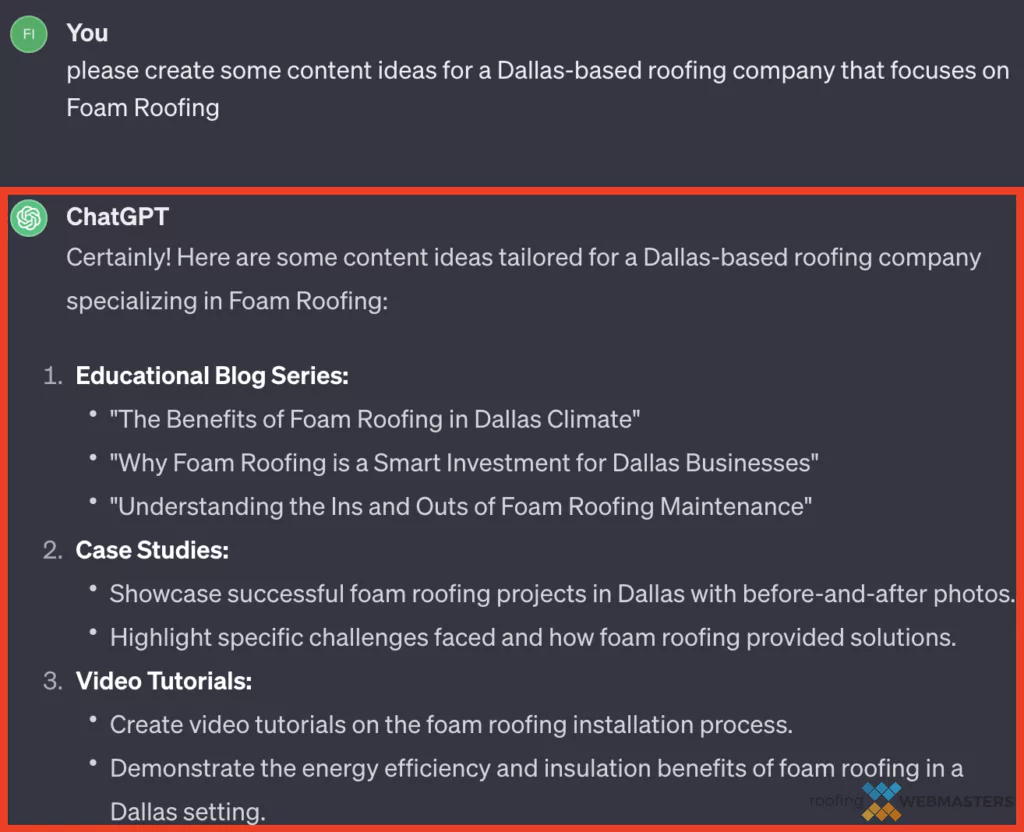
Other AI Tools
Thousands of AI-powered SEO tools have emerged, whether using Open AI’s API or other sources like Amazon Web Services (AWS) AI.
While some of these tools are valuable, it’s important to be skeptical of all of them. Many of them promise to deliver SEO results that are not actually possible.
You should also be wary of content writing tools that claim to write full articles. Most of these tools use API from Open AI, which means they essentially use ChatGPT to write the articles, which you can do manually.
As more AI tools emerge, it’s important to conduct reputation checks and try the tools before spending money. Some of these tools will be very helpful, while others will be hype-driven and insufficient for SEO practices.
Here are some of the best AI tools right now:
Exclusive SEO Tip: Rank for Shingle Brands
Most SEO guides you read will rehash drivel from elsewhere on the web. As a long-time owner of the most cutting-edge SEO agency for roofers, I have unique insights that can separate your company from competitors. My best example of this is helping roofers rank for shingle brands on Google.
Unique Local Content
99.9% of local roofers are targeting the same keywords. Unfortunately, that means they all leave valuable organic clicks on the table. About half of your clicks come from long-tail keywords, which roofers fail to optimize for.
Targeting shingle brands in your service areas is a great way to pick up some of these hidden clicks. You can use DataPins to continually insert shingle brand keywords into your local content based on real-life jobs.
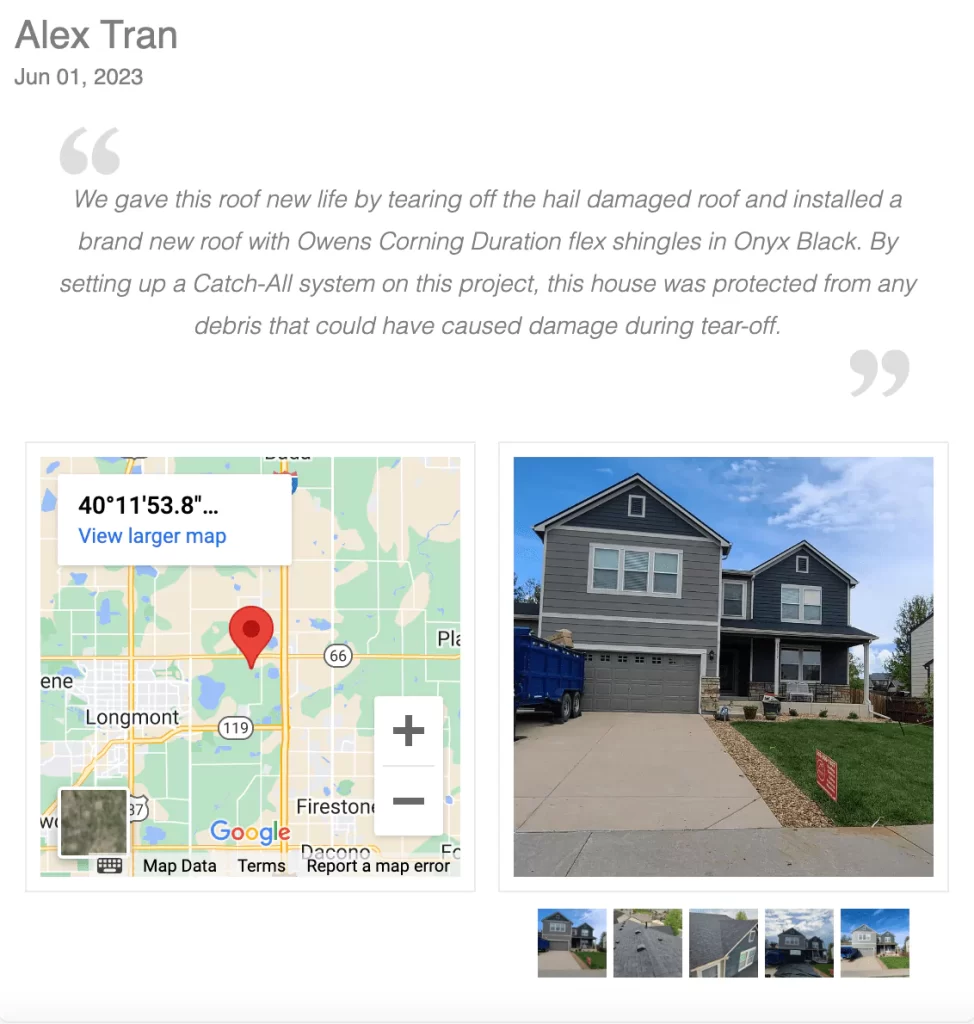
Adapting to Google Algorithm Updates
Google has a rich history of algorithm updates from Panda to Penguin that have changed the landscape of search engine optimization. Major algorithm updates typically target trends marketers use to manipulate search results for their clients and themselves.
For example, building backlinks with exact-match anchor text was a popular and effective strategy until Google’s Penguin update obliterated websites engaging in this practice.
Before that, the Panda update set its sights on “content farms” that used keyword manipulation so thin websites and low-quality content could outrank more informative articles.
Major algorithm updates have recently targeted manipulative content creation practices that utilize modern technology. I will outline two of Google’s most significant updates.
Helpful Content Update
The August 2022 Helpful Content Update was the first major algorithm update to target wide-scale content practices used by various marketing agencies. The onset of ChatGPT and other AI content-generation tools certainly prompted Google to take quick and decisive action with content generation.
While the HCU does not specifically target AI content, it does target the practice of mass-producing content for search engines rather than readers. Unfortunately, many roofing marketing companies misused content for years – long before ChatGPT emerged.
Because of this, many roofing company websites were hit by the Helpful Content Update and dropped in rankings and traffic.
My agency has helped many of these websites recover by removing unhelpful content and focusing on people-first content that meets the users’ intent and needs.
March 2024 Core Update
Google’s March 2024 Core Update further enforced systems introduced in the Helpful Content Update. Roofing companies saw even more ranking drops after March because of the increased scrutiny of mass-produced content, which is quite common with blog posts.
Within the documentation for this update, Google referred to a practice called “scaled content abuse,” which generates many pages for search engine manipulation. In the world of SEO for roofers, this aligns with “city pages” or “local landing pages” along with blog posts.
It’s becoming increasingly important for Google and its users to trust the author of website content. My agency developed a SAAS tool, DataPins, to inject legitimate branded signaling through schema markup and unique job images so that websites can meet Google’s new standards for E-E-A-T.
Choosing an SEO Agency
For most roofing companies, incorporating SEO yourself is a tall task. You don’t have the time or resources to devote to everything this guide covers.
As a result, you will have to choose a good SEO company to implement these strategies on your behalf. Before selecting roofing SEO services for your company, you should consider a few things.
Case Studies
Does the SEO company have a proven track record of success? Many have case studies on their website demonstrating organic traffic improvements over a fixed period. Of course, you shouldn’t automatically trust these studies. Still, the fact that they can showcase previous results is a green flag.
Pricing
SEO service pricing is a significant factor for roofers. After all, who wants to pay $5,000+ per month for SEO?
The most honest agencies charge between $500 and $2,500 monthly for search engine optimization, which is an excellent budget for your SEO campaign. Be careful, however, as some agencies lock you into a long-term contract.
Once you get stuck in a 12 or 24-month agreement, leaving your agency becomes more frustrating and expensive.
Reviews
You learned how reviews impact your roofing company and its SEO. The same is true for whichever agency you research on Google.
Check the Google Reviews for your top 3 agency considerations and compare and contrast the feedback. Google Reviews is the most trustworthy source as it guards against fake reviews or spam reviews.
Comfort
Last but not least is your comfort level with the SEO provider. Does your point of contact sound like a salesperson? Or do they sound like someone who genuinely understands SEO for roofing contractors and how it can apply to your online campaign?
In addition, attentive SEO specialists should craft a unique plan for your company. Perhaps you offer a specialty service which they should represent on your company website.
Nolen’s Last Words on Roofing SEO
As a former blue-collar business owner and the owner of a long-running SEO agency, I speak from experience, expertise, and empathy.
The minutia of a title tag and a meta description only matter in the context of how it can help your roofing business thrive.
As a token of my respect and admiration from one American business owner to the next, I want to offer you this free PDF on Google’s upcoming search generative experience.
And be sure to bookmark this guide as I regularly update it based on the latest trends in Roofing SEO.




